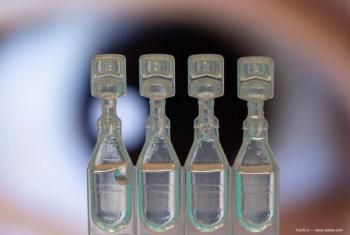
Laser photocoagulation still standard of care for diabetic maculopathy
The Early Treatment Diabetic Retinopathy Study (EDTRS) laser is still the standard of care of diabetic maculopathy. There is enthusiastic support for the potential of pharmaceutical therapy, using anti-vascular endothelial growth factor agents, however, the laser remains the gold standard, said Francesco Bandello, MD, of the University of Udine, Udine, Italy.
The Early Treatment Diabetic Retinopathy Study (ETDRS) laser isstill the standard of care of diabetic maculopathy. There isenthusiastic support for the potential of pharmaceutical therapy,using anti-vascular endothelial growth factor agents, however,the laser remains the gold standard, said Francesco Bandello, MD,of the University of Udine, Udine, Italy.
Focal and grid techniques are used to address diabeticmaculopathy, and with both come the complications of laser burns,progressive retinal pigment epithelial atrophy, progressiveenlargement of laser scars, and central scotomas.
The classic laser treatment was modified to circumvent thesecomplications and reduce tissue damage with the hopes thatsubthreshold diode micro pulse laser and the PASCAL system thatapplies short pulses to the retinal tissue would beefficacious.
"Theoretically,” Dr. Bandello reported, "these systems should havebeen able to produce fewer side effects and less damage whilemaintaining the efficacy of the classic treatment. However, themilder laser treatment was not as effective 12 months after thetreatment compared with the conventional laser.”
The role of optical coherence tomography (OCT) also has beeninvestigated to determine when laser treatment should be appliedin patients with diabetic maculopathy. A meta-analysis of thistopic found that if there is no doubt about a diagnosis ofmaculopathy, OCT is not needed. In cases in which there is doubtabout the presence of edema or the macular thickness is less than250 µm, there is no need for laser treatment; when themacula is more than 300 µm, laser treatment is indicated,according to Dr. Bandello.
"Despite the potential theoretic advantages offered by the newlasers, the ETDRS technique still appears to be the mosteffective way to treat diabetic macular edema (DME). The resultsof long-term trials of these lasers are needed,” Dr. Bandellosaid. "There is also the potential for the combining of drugs andlaser treatment to improve the effect of treatment overall of DMEand reduce the side effects.”
Newsletter
Don’t miss out—get Ophthalmology Times updates on the latest clinical advancements and expert interviews, straight to your inbox.














































.png)


